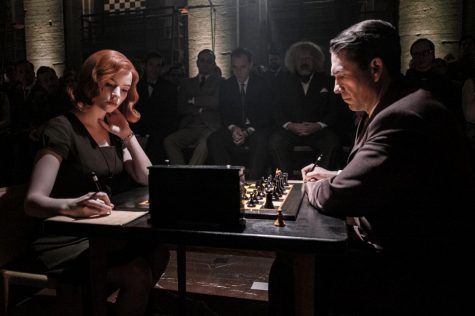The Queen’s Gambit: Dominating Chess One King at a Time
Pawn to Queen 4. Pawn to Queen 5. Pawn to Queen’s Bishop 4. Pawn takes pawn. Knights and rooks dance around checkered squares while black and white battle it out, vying for control over the center of the board. It’s silent, except for the faint ticking of the clock, as tension rises between the two players. And viewers are on the edge of their seats for everyone’s favorite sport… chess?
Yes, chess, the elegant game of intellect that happens to be the focal point of Netflix’s most recent limited series, The Queen’s Gambit. Based on Walter Tevis’ psychological thriller, the show follows American chess prodigy Elizabeth Harmon (the marvelous Anya Taylor-Joy) in her journey to master the male-dominated sport. Her story starts in the 1950s at a dreary Christian school for orphans after her mother dies, where she is introduced to chess by the school’s janitor. Unfortunately, at a young age, she also develops a dependence on the tranquilizers the orphanage uses to keep the girls at bay. Shortly after being adopted, Beth publicly emerges into the world of chess as a force to be reckoned with, and her rise to the top begins.
Now, the idea of watching people sitting down and thinking for seven hours may not immediately sound appealing. However, the beauty of The Queen’s Gambit comes from its ability to captivate its audience even in scenes where Beth is binge reading chess theory or contemplating her next move. The series’ exterior elements—its instrumental score, production and costume design, and dark color palette (dare I say, a dark academia aesthetic)—keep viewers intrigued. And of course, breathtaking performances by Anya Taylor-Joy and the strong supporting cast, including Thomas Brodie-Sangster, Moses Ingram, and Bill Camp, never leave you unentertained.
And good news for most viewers: no previous chess knowledge is required! The series is engaging from its first episode, even if its references to the Sicilian defense or grandmaster Paul Morphy go over your head. Whether you’ve played for years or have never touched a chess piece in your life, you’ll be mesmerized by the intricate strategies Beth uses to dominate the game.

Nonetheless, Beth’s chess career is not the only star of the show. Throughout the series, we also witness the highs and lows of her personal life as she walks the line between genius and madness. The Queen’s Gambit effectively opens a discussion of more serious topics through Beth’s ongoing struggles with drug addiction, alcoholism, obsession, and childhood trauma. Her feminist story of success is also one of coming of age, where layers of complexity are added to the show’s narrative as Beth grapples with her vices, explores her sexual identity, and finds comfort in her found family.
While the series showcases well-developed character arcs and a strong, unapologetic female protagonist, it falls short in its discussion of race. The racial diversity is practically nonexistent, with the exception of Jolene, Beth’s childhood best friend. Not only is she the only Black character relevant to the series, but she’s also written as the stereotypical token person of color who only exists to make the white protagonist’s life easier. Though viewers are given some information about her, Jolene barely has any screen time, and the show misses an opportunity for better representation and social commentary.
Overall, the combination of its quality production, captivating plotline, and Beth’s internal conflicts make The Queen’s Gambit worthy of a binge watch. But the cherry on top is watching Beth dethrone one arrogant man after another— there’s just something so satisfying about her beating them at their own game.



